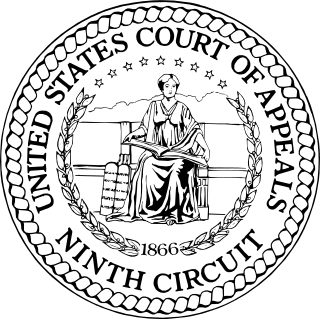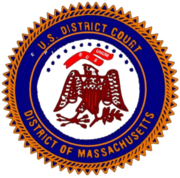
The Racketeer Influenced and Corrupt Organizations (RICO) Act is a United States federal law that provides for extended criminal penalties and a civil cause of action for acts performed as part of an ongoing criminal organization.
A statute of limitations, known in civil law systems as a prescriptive period, is a law passed by a legislative body to set the maximum time after an event within which legal proceedings may be initiated. In the United States, a government agency is permitted by the Congress to create under federal regulations its own statute of limitations.
An affirmative defense to a civil lawsuit or criminal charge is a fact or set of facts other than those alleged by the plaintiff or prosecutor which, if proven by the defendant, defeats or mitigates the legal consequences of the defendant's otherwise unlawful conduct. In civil lawsuits, affirmative defenses include the statute of limitations, the statute of frauds, waiver, and other affirmative defenses such as, in the United States, those listed in Rule 8 (c) of the Federal Rules of Civil Procedure. In criminal prosecutions, examples of affirmative defenses are self defense, insanity, entrapment and the statute of limitations.
The Computer Fraud and Abuse Act of 1986 (CFAA) is a United States cybersecurity bill that was enacted in 1986 as an amendment to existing computer fraud law, which had been included in the Comprehensive Crime Control Act of 1984. The law prohibits accessing a computer without authorization, or in excess of authorization. Prior to computer-specific criminal laws, computer crimes were prosecuted as mail and wire fraud, but the applying law was often insufficient.

The United States No Electronic Theft Act , a federal law passed in 1997, provides for criminal prosecution of individuals who engage in copyright infringement under certain circumstances, even when there is no monetary profit or commercial benefit from the infringement. Maximum penalties can be five years in prison with fines.
Mail fraud and wire fraud are federal crimes in the United States that involve mailing or electronically transmitting something associated with fraud. Jurisdiction is claimed by the federal government if the illegal activity crosses interstate or international borders.
Dowling v. United States, 473 U.S. 207 (1985), was a United States Supreme Court case that discussed whether copies of copyrighted works could be regarded as stolen property for the purposes of a law which criminalized the interstate transportation of property that had been "stolen, converted or taken by fraud" and holding that they could not be so regarded under that law.
In criminal law, a conspiracy is an agreement between two or more persons to commit a crime at some time in the future. Criminal law in some countries or for some conspiracies may require that at least one overt act be undertaken in furtherance of that agreement, to constitute an offense. There is no limit on the number participating in the conspiracy and, in most countries, no requirement that any steps have been taken to put the plan into effect. For the purposes of concurrence, the actus reus is a continuing one and parties may join the plot later and incur joint liability and conspiracy can be charged where the co-conspirators have been acquitted or cannot be traced. Finally, repentance by one or more parties does not affect liability but may reduce their sentence.
The Federation Against Copyright Theft (FACT) is an organisation established in 1983 to protect and represent the interests of its members' intellectual property (IP). FACT also investigates fraud and cybercrime, and provides global due diligence services to support citizenship investment and trade, business, financial and legal compliance.
The Double Jeopardy Clause of the Fifth Amendment to the United States Constitution provides: "[N]or shall any person be subject for the same offence to be twice put in jeopardy of life or limb..." The four essential protections included are prohibitions against, for the same offense:

Copyright infringement is the use of works protected by copyright without permission for a usage where such permission is required, thereby infringing certain exclusive rights granted to the copyright holder, such as the right to reproduce, distribute, display or perform the protected work, or to make derivative works. The copyright holder is typically the work's creator, or a publisher or other business to whom copyright has been assigned. Copyright holders routinely invoke legal and technological measures to prevent and penalize copyright infringement.
Honest services fraud is a crime defined in 18 U.S.C. § 1346, added by the United States Congress in 1988, which states "For the purposes of this chapter, the term scheme or artifice to defraud includes a scheme or artifice to deprive another of the intangible right of honest services."
McNally v. United States, 483 U.S. 350 (1987), was a case in which the United States Supreme Court decided that the federal statute criminalizing mail fraud applied only to the schemes and artifices defrauding victims of money or property, as opposed to those defrauding citizens of their rights to good government. The case was superseded one year later when the United States Congress amended the law to specifically include honest services fraud in the mail and wire fraud statutes.

United States v. Nosal, 676 F.3d 854 was a United States Court of Appeals for the Ninth Circuit decision dealing with the scope of criminal prosecutions of former employees under the Computer Fraud and Abuse Act (CFAA). The Ninth Circuit's first ruling established that employees have not "exceeded authorization" for the purposes of the CFAA if they access a computer in a manner that violates the company's computer use policies—if they are authorized to access the computer and do not circumvent any protection mechanisms.
Several statutes, mostly codified in Title 18 of the United States Code, provide for federal prosecution of public corruption in the United States. Federal prosecutions of public corruption under the Hobbs Act, the mail and wire fraud statutes, including the honest services fraud provision, the Travel Act, and the Racketeer Influenced and Corrupt Organizations Act (RICO) began in the 1970s. "Although none of these statutes was enacted in order to prosecute official corruption, each has been interpreted to provide a means to do so." The federal official bribery and gratuity statute, 18 U.S.C. § 201, the Foreign Corrupt Practices Act (FCPA) 15 U.S.C. § 78dd, and the federal program bribery statute, 18 U.S.C. § 666 directly address public corruption.
Criminal copyright laws prohibit the unacknowledged use of another's intellectual property for the purpose of financial gain. Violation of these laws can lead to fines and jail time. Criminal copyright laws have been a part of U.S. laws since 1897, which added a misdemeanor penalty for unlawful performances if "willful and for profit". Criminal penalties were greatly expanded in the latter half of the twentieth century, and those found guilty of criminal copyright infringement may now be imprisoned for decades, and fined hundreds of thousands of dollars.
United States v. Vampire Nation, 451 F.3d 189, is a 2006 decision of the United States Court of Appeals for the Third Circuit regarding the Federal Sentencing Guidelines and asset forfeiture. A three-judge panel unanimously affirmed the conviction and sentence of Frederick Banks, a Pittsburgh man, on numerous felony charges resulting from fraudulent schemes carried out over the Internet. The case takes its title, which has been singled out as memorable and included among lists of amusingly titled cases, from one of Banks' aliases, an electronic music group of which he was the sole regular member. He had filed the appeal under that name while representing himself.
Remedies for copyright infringement in the United States can be either civil or criminal in nature. Criminal remedies for copyright infringement prevent the unauthorized use of copyrighted works by defining certain violations of copyright to be criminal wrongs which are liable to be prosecuted and punished by the state. Unlike civil remedies, which are obtained through private civil actions initiated by the owner of the copyright, criminal remedies are secured by the state which prosecutes the infringing individual or organisation.

Attorney General v Oldridge[2000] IESC 29; [2000] 4 IR 593 was an Irish Supreme Court case which examined "whether corresponding offenses to wire fraud existed in Irish law." The court found that although "wire fraud" did not exist in Irish law, the criminal activity was covered by existing fraud laws. The result of this decision was to broaden the use of fraud and specifically to rule that the charge of "conspiracy to defraud" is constitutional.
Pasquantino v. United States, 544 U.S. 349 (2005), is a United States Supreme Court case in which the Court held that a plot to defraud a foreign government of tax revenue violates the federal wire fraud statute.




